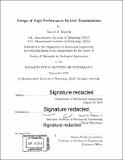Design of high performance hybrid transmissions
Author(s)
Dorsch, Daniel Scott.
Download1139336911-MIT.pdf (13.41Mb)
Other Contributors
Massachusetts Institute of Technology. Department of Mechanical Engineering.
Advisor
Amos G. Winter, V.
Terms of use
Metadata
Show full item recordAbstract
This thesis explores the design, development, and evaluation of transmission systems for integration into high-performance hybrid (internal combustion engine (ICE) and electric motor) vehicles. Traditional hybrid vehicle designs often fall into one of two categories. Every day road vehicles typically utilize hybridization for increased drivetrain efficiency, including traits such as low speed electric drive and regenerative braking. Alternatively, performance cars have typically utilized the electric motor functionality for increased performance. By using a new framework for analyzing the elements and their function within a propulsion system architecture, advanced hybrid architectures that allow for both high efficiency and increased performance are presented. A two-motor, clutchless hybrid transmission concept was developed. An analysis of driving modes available demonstrates the utility in a high-performance vehicle, increasing the performance and efficiency of the drivetrain. A second, dual-shaft, single motor, clutchless transmission concept is presented, with the benefits and drawbacks of this architecture compared to the two-motor architecture, and a traditional ICE only transmission. The final part of this thesis presents a novel, two-speed electric motor system that could be integrated within a conventional ICE automated manual transmission. This system utilizes custom sensors for tracking the position of the dogteeth within the two-speed shift synchronizer. Electric motor control is used to synchronize motor speed during a shift event, as the inertia of the electric motor is too large for friction synchronization alone to be sufficient. This strategy removes the tradeoff that currently exists for optimal shift actuator design (larger pistons result in faster speed synchronization but slower actuation motion during other phases of a shift) and results in overall faster gearshifts. Dogtooth tracking allows for firing of the shift actuator at the proper moment, ensuring no collision between dogteeth and allowing for faster shifter motion than with a traditional synchronizer. An experimental setup was developed to characterize shift performance. Full gearshifts can be made successfully utilizing speed matching and dogtooth tracking, validating the described shift control method and allowing for improved, frictionless synchronizer designs. The developments described in this work will lead to a new generation of hybrid vehicles, designed for high-performance and increased efficiency.
Description
Thesis: Ph. D., Massachusetts Institute of Technology, Department of Mechanical Engineering, 2019 Cataloged from PDF version of thesis. Includes bibliographical references (pages 111-118).
Date issued
2019Department
Massachusetts Institute of Technology. Department of Mechanical EngineeringPublisher
Massachusetts Institute of Technology
Keywords
Mechanical Engineering.